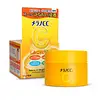What's inside
What's inside
 Key Ingredients
Key Ingredients

 Benefits
Benefits

 Concerns
Concerns

No concerns
 Ingredients Side-by-side
Ingredients Side-by-side

Ascorbyl Glucoside
AntioxidantTocopheryl Acetate
AntioxidantDipotassium Glycyrrhizate
HumectantAscorbic Acid
AntioxidantAlpinia Katsumadai Seed Extract
Skin ConditioningCitrus Limon Fruit Extract
MaskingCornus Officinalis Fruit Extract
Skin ConditioningC4-18 Alkyl Methacrylate/Methacryloyloxyethyl Phosphorylcholine Copolymer
HumectantButylene Glycol
HumectantPentylene Glycol
Skin ConditioningGlycerin
HumectantBifida Polysaccharide
HumectantPentaerythrityl Tetraethylhexanoate
EmollientPPG-17 Butyl Ether
Skin ConditioningPotassium Hydroxide
BufferingPolyvinylalcohol Crosspolymer
Diethoxyethyl Succinate
SolventPEG-8 Dimethicone
EmulsifyingPolyglyceryl-2 Hydroxypropyl Ethylhexyl Ether
CleansingPolyacrylamide
Phenoxyethanol
PreservativeGlyceryl Hydroxystearate
EmollientParaffinum Liquidum
EmollientPEG-20 Sorbitan Isostearate
EmulsifyingSodium Paraben
PreservativeBehenyl Alcohol
EmollientCetearyl Alcohol
EmollientPPG-4 Lauryl Ether
EmollientXanthan Gum
EmulsifyingC16-24 Alkyl C16-24 Acidate
Skin ConditioningAcrylates/C5-8 Alkyl Acrylate Copolymer
Emulsion StabilisingParfum
MaskingAscorbyl Glucoside, Tocopheryl Acetate, Dipotassium Glycyrrhizate, Ascorbic Acid, Alpinia Katsumadai Seed Extract, Citrus Limon Fruit Extract, Cornus Officinalis Fruit Extract, C4-18 Alkyl Methacrylate/Methacryloyloxyethyl Phosphorylcholine Copolymer, Butylene Glycol, Pentylene Glycol, Glycerin, Bifida Polysaccharide, Pentaerythrityl Tetraethylhexanoate, PPG-17 Butyl Ether, Potassium Hydroxide, Polyvinylalcohol Crosspolymer, Diethoxyethyl Succinate, PEG-8 Dimethicone, Polyglyceryl-2 Hydroxypropyl Ethylhexyl Ether, Polyacrylamide, Phenoxyethanol, Glyceryl Hydroxystearate, Paraffinum Liquidum, PEG-20 Sorbitan Isostearate, Sodium Paraben, Behenyl Alcohol, Cetearyl Alcohol, PPG-4 Lauryl Ether, Xanthan Gum, C16-24 Alkyl C16-24 Acidate, Acrylates/C5-8 Alkyl Acrylate Copolymer, Parfum
Arbutin
AntioxidantDipotassium Glycyrrhizate
HumectantDipropylene Glycol
HumectantGlycerin
Humectant2-Ethylhexanol
1,5-Pentanediol
SolventMilk Ferment
Skin ConditioningEel Extract
HumectantButylene Glycol
HumectantAcrylic Acid
C8-22 Alkyl Acrylates/Methacrylic Acid Crosspolymer
Glycerin Methyl Ether
Diethylhexyl Sodium Sulfosuccinate
CleansingSodium Stearoyl Glutamate
CleansingEthylhexanal
PerfumingSodium Metabisulfite
AntioxidantBehenyl Alcohol
EmollientDecylene Glycol
Skin ConditioningHexamethylenediamine/Mdi Copolymer
Magnesium Ascorbyl Phosphate
AntioxidantSodium Oxide
BufferingTocopherol
AntioxidantPhenoxyethanol
PreservativeArbutin, Dipotassium Glycyrrhizate, Dipropylene Glycol, Glycerin, 2-Ethylhexanol, 1,5-Pentanediol, Milk Ferment, Eel Extract, Butylene Glycol, Acrylic Acid, C8-22 Alkyl Acrylates/Methacrylic Acid Crosspolymer, Glycerin Methyl Ether, Diethylhexyl Sodium Sulfosuccinate, Sodium Stearoyl Glutamate, Ethylhexanal, Sodium Metabisulfite, Behenyl Alcohol, Decylene Glycol, Hexamethylenediamine/Mdi Copolymer, Magnesium Ascorbyl Phosphate, Sodium Oxide, Tocopherol, Phenoxyethanol
Alternatives
Ingredients Explained
These ingredients are found in both products.
Ingredients higher up in an ingredient list are typically present in a larger amount.
Behenyl Alcohol is a type of fatty alcohol (these are different from the drying, solvent alcohols).
Fatty Alcohols have hydrating properties and are most often used as an emollient or to thicken a product. They are usually derived from natural fats and oils; behenyl alcohol is derived from the fats of vegetable oils.
Emollients help keep your skin soft and hydrated by creating a film that traps moisture in.
In 2000, Behenyl Alcohol was approved by the US as medicine to reduce the duration of cold sores.
Learn more about Behenyl AlcoholButylene Glycol (or BG) is used within cosmetic products for a few different reasons:
Overall, Butylene Glycol is a safe and well-rounded ingredient that works well with other ingredients.
Though this ingredient works well with most skin types, some people with sensitive skin may experience a reaction such as allergic rashes, closed comedones, or itchiness.
Learn more about Butylene GlycolDipotassium Glycyrrhizate comes from licorice root.
Extracts of licorice have demonstrated to have antibacterial, anti‐inflammatory, antiviral, antioxidant properties.
One component, glabridin, has extra potent antioxidant and soothing properties. It has also been found to block pigmentation from UVB rays in guinea pigs.
Licorice Root also contains a flavonoid. Flavonoids are a natural substance from in plants. Flavonoids also have antioxidant properties.
Another component, glycyrrhizin, has been found to have anti-inflammatory and antimicrobial benefits. This may make licorice root extract effective at treating acne. However, more research is needed to support this.
Liquiritin is one of the flavone compounds found in licorice. It has been found to help lighten skin by preventing tyrosinase from reacting with tyrosine. When the two react, protein is converted to melanin. Melanin is the substance in your body that gives your features pigmentation.
Licorice root is native to Southern Europe and Asia. It has been used in traditional Chinese medicine to help with respiratory issues.
Learn more about Dipotassium GlycyrrhizateGlycerin is already naturally found in your skin. It helps moisturize and protect your skin.
A study from 2016 found glycerin to be more effective as a humectant than AHAs and hyaluronic acid.
As a humectant, it helps the skin stay hydrated by pulling moisture to your skin. The low molecular weight of glycerin allows it to pull moisture into the deeper layers of your skin.
Hydrated skin improves your skin barrier; Your skin barrier helps protect against irritants and bacteria.
Glycerin has also been found to have antimicrobial and antiviral properties. Due to these properties, glycerin is often used in wound and burn treatments.
In cosmetics, glycerin is usually derived from plants such as soybean or palm. However, it can also be sourced from animals, such as tallow or animal fat.
This ingredient is organic, colorless, odorless, and non-toxic.
Glycerin is the name for this ingredient in American English. British English uses Glycerol/Glycerine.
Learn more about GlycerinPhenoxyethanol is a preservative that has germicide, antimicrobial, and aromatic properties. Studies show that phenoxyethanol can prevent microbial growth. By itself, it has a scent that is similar to that of a rose.
It's often used in formulations along with Caprylyl Glycol to preserve the shelf life of products.